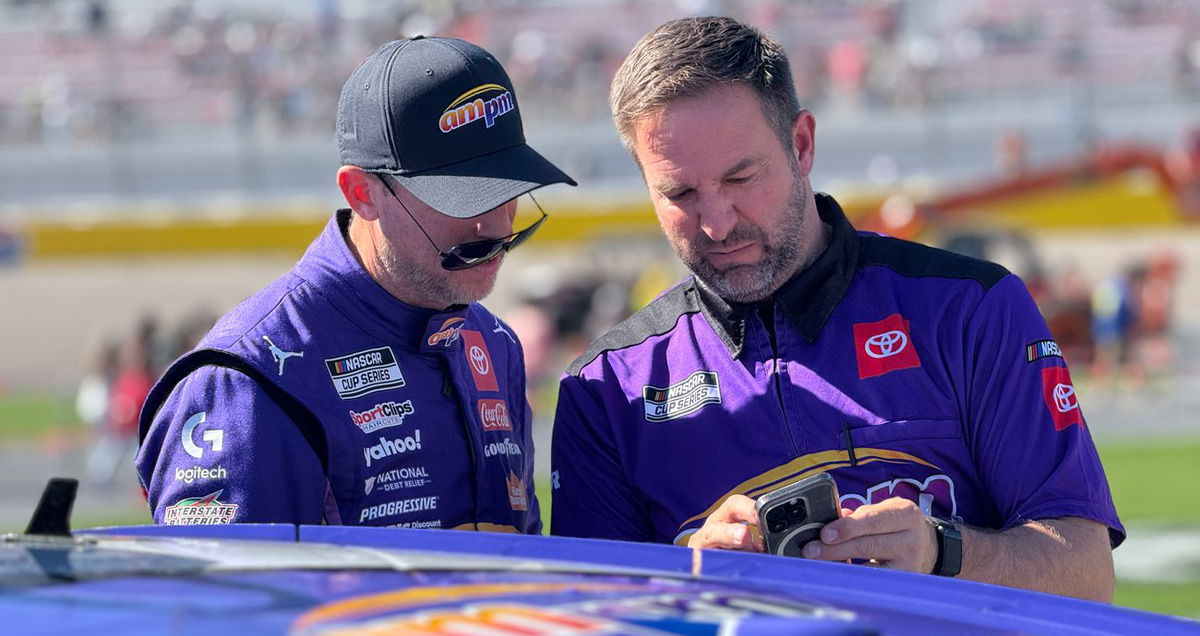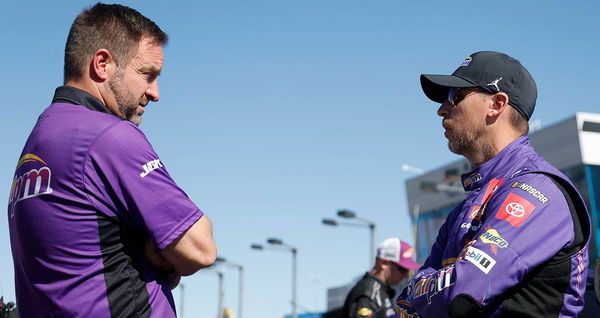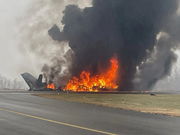
Imago
Credits: Zach Sturniolo | NASCAR Digital Media

Imago
Credits: Zach Sturniolo | NASCAR Digital Media
The No. 11 Joe Gibbs Racing team entered the race as the clear favorite, with Hamlin leading 208 laps and appearing set to finally capture his first NASCAR Cup Series title. However, a late caution towards the end forced a high-stakes decision on pit road: whether to take two tires, four tires, or stay out. His crew chief, Chris Gayle, chose four, and the move dropped Hamlin from the front row to 11th for the overtime restart, ultimately costing him the championship.
Watch What’s Trending Now!
Fans are seeing this just in black and white, and they are hating Chris Gayle for that pit strategy call, pinning everything down to that one act. But amidst all these criticisms, NBC analyst Steve Letarte stepped up to defend Gayle.
ADVERTISEMENT
Letarte on why Gayle’s four-tire strategy was right
Post-race, Letarte addressed the backlash on NBC’s post-race coverage, saying he understood the reasoning behind the call. “I thought four tires were the right call. I thought about this as I walked down here from the booth. I think Friday affected today. I think of Corey Heim, when he took four tires…and I thought he had lost the race.”
But Corey Heim won. So Letarte first referenced the Truck finale to explain how the same call gave a totally opposite result there. The parallel between Heim’s strategy and Gayle’s was clear; both gambled on performance over position, only for track circumstances to turn against them.
He continued by explaining how prior racing incidents shaped his thinking on strategy. “And the seven-wide move (in the Truck race) influenced my opinion tonight, which was like, ‘I’m going to take four tires’. So here’s what I tell people, and this is like a really unpopular statement, but the truth is…It’s not just what the right call is. It’s ‘What am I okay losing with?’”
ADVERTISEMENT
Letarte’s words highlighted the human element behind split-second pit decisions. For crew chiefs, he explained, it isn’t simply about data but about integrity, making the call you can live with, win or lose.
ADVERTISEMENT

“Because what are you going to be able to lay your head down at night? So if I’m Chris Gayle, I take four tires, and here’s why: Denny Hamlin’s had a monster day. He has had the best car. He’s 20 years in the making…I really believe that if you run this restart five or six times, it’s a coin flip whether four tires work!”
ADVERTISEMENT
Letarte pointed to Hamlin’s dominance throughout the race, noting that the No. 11 Toyota had been in a class of its own before the late caution. The decision, in his view, wasn’t reckless but a logical attempt to preserve Hamlin’s winning pace on fresh rubber.
In the TV Booth I don’t root for anyone…but I was a little heartbroken for Denny Hamlin today…👇 pic.twitter.com/Ia1DVlQ1Qb
— Steve Letarte (@SteveLetarte) November 3, 2025
Letarte also pushed back against the idea that the outcome proved the strategy wrong. “I know everybody is going to tell me I am wrong ‘cause they know the results are in, but I am telling you if you run this data multiple times, I am not sure it’s just obvious that the four tires lose. I think Kyle Larson, who’s in disbelief walking around here like it’s a dream, isn’t giving himself enough credit of driving bada– on two tires.”
ADVERTISEMENT
His remark praised Larson’s execution on the final restart. The Hendrick Motorsports driver launched perfectly off Turn 1 to capture his second career championship. In Letarte’s eyes, it wasn’t the strategy that cost Denny Hamlin, but Larson’s skill under pressure that decided the race.
And what’s more, Denny Hamlin’s ex-crew chief, Chris Gabehart, also used the exact same metaphor of a “coin flip” like Letarte.
“It’s a coin flip. You had cars that had stayed out. With the tire wear, the way it was, the championship four cars, is something that I never ever would have imagined,” Gabehart said. He also believed that the tires were not to blame, as no matter how good they make them, it’s their job to exploit them as much as they can to perform better. “You can’t blame Goodyear. We are beating the crap out of these tires trying to go fast.”
ADVERTISEMENT
Data from post-race analysis support Letarte’s argument. According to NASCAR’s loop data, Hamlin’s car had the highest long-run speed average, while Larson’s restarts ranked among the top three in short-run performance. Tire strategy has long been one of Phoenix’s biggest variables, and as Letarte noted, the outcome could have easily flipped with a different restart line or cleaner air.
In defending Gayle, Letarte offered a reminder of what racing strategy truly entails, balancing logic, instinct, and trust between driver and crew chief. The call for four tires might have cost Hamlin the trophy, but it reflected faith in performance, not fear of risk. As Letarte summed up, sometimes being able to sleep at night matters more than playing it safe. Letarte’s defense ties straight to the tire chaos that sparked the call.
Top Stories
Fact Check: Were Greg Biffle & Family On the Plane That Crashed At Statesville, North Carolina?

Who Is Greg Biffle’s Wife? Everything You Need to Know About Cristina Grossu

Footage Surfaces of Florida Police Arresting NASCAR Veteran Over Disturbing Public Misbehavior

Controversial Crew Chief Finds Fresh Start With 17-Yo NASCAR Team

Greg Biffle Plane Tragedy: What Might Have Caused the Crash That Killed the NASCAR Champ and His Family

ADVERTISEMENT
Hamlin shields Goodyear
From the very start of the Phoenix weekend, the warning signs were clear about the tire situation. The one-hour practice session had already been marred by chaos, with at least six drivers suffering tire failures and four separate red flags halting the action. What began as a troublesome preview turned into the defining storyline of the championship race itself, as every one of the four title contenders, including Denny Hamlin, battled tire issues before the day was over.
From Chase Briscoe’s early misfortune to Larson’s own mid-race scare, tire trouble became the equalizer that spared no contender. But the drama reached its breaking point in the closing laps when William Byron’s right-rear tire gave way while running second, sending his No. 24 Chevrolet into the SAFER barrier in Turn 3. That single moment flipped the race on its head, snatching the lead from Denny Hamlin and serving Kyle Larson the lifeline he needed to claim his second Cup championship.
Once the caution flew on Lap 309, strategy went out the window. Brad Keselowski, Ryan Preece, and Alex Bowman gambled by staying out on worn tires, while six others opted for right-sides only. Hamlin and his crew went the conservative route, bolting on four fresh Goodyears, but the call dropped him to 11th in the running order. Ultimately, Larson finished third while Hamlin sixth.
ADVERTISEMENT
Yet, even after the heartbreak of that magnitude, Hamlin refused to point fingers at Goodyear. “Well, I think they (Goodyear) did a great job all season long, and it’s not their fault that we’re running the tires flat. So, I really applaud them and the tires that they’ve continued to bring to the racetrack and keep pushing the limits on softer to try to put it back in the driver’s hands. It’s the teams,” Hamlin said post-race.
The No. 11 JGR driver acknowledged the reality of modern Cup racing that teams push tire pressures to the brink because that’s where the performance lies. “It’s not the design of the tire. We’re just running our tires super low because that’s where they perform the best, and everyone’s testing the limits, and a lot of people found it.”
However, no amount of reasons could help Hamlin with his disappointment. A dejected Hamlin admitted his spirit had hit rock bottom, saying, as of now, he doesn’t even want to race a car again as his fun meter’s pegged. Still, for a competitor as consistent as Hamlin, walking away seems easier said than done. His love for the sport and his unfulfilled pursuit of the Cup title will likely pull him back into the fight once more.
ADVERTISEMENT
ADVERTISEMENT
ADVERTISEMENT

